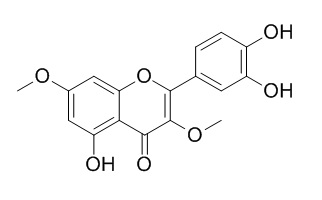3,7-Di-O-methylquercetin
3,7-Di-O-methylquercetin shows α-glucosidase inhibition.
Inquire / Order:
manager@chemfaces.com
Technical Inquiries:
service@chemfaces.com
Tel:
+86-27-84237783
Fax:
+86-27-84254680
Address:
1 Building, No. 83, CheCheng Rd., Wuhan Economic and Technological Development Zone, Wuhan, Hubei 430056, PRC
Providing storage is as stated on the product vial and the vial is kept tightly sealed, the product can be stored for up to
24 months(2-8C).
Wherever possible, you should prepare and use solutions on the same day. However, if you need to make up stock solutions in advance, we recommend that you store the solution as aliquots in tightly sealed vials at -20C. Generally, these will be useable for up to two weeks. Before use, and prior to opening the vial we recommend that you allow your product to equilibrate to room temperature for at least 1 hour.
Need more advice on solubility, usage and handling? Please email to: service@chemfaces.com
The packaging of the product may have turned upside down during transportation, resulting in the natural compounds adhering to the neck or cap of the vial. take the vial out of its packaging and gently shake to let the compounds fall to the bottom of the vial. for liquid products, centrifuge at 200-500 RPM to gather the liquid at the bottom of the vial. try to avoid loss or contamination during handling.
Viruses.2024, 16(7):1128.
Russian Journal of Bioorganic Chemistry2023, 49:1689�C1698.
Asian J of Pharmaceutical&Clinical 2018, 11(2)
J Neuroinflammation.2020, 17(1):75.
Drug Test Anal.2018, 10(10):1579-1589
SBRAS2016, 12
J Mol Med (Berl).2018, 96(7):661-672
Plant Cell Tiss Org2020, 1-16
J Ethnopharmacol.2017, 206:73-77
Advances in Traditional Medicine2020, 10.1007
Related and Featured Products
Phytother Res. 2016 Oct;30(10):1624-33.
Phytochemical and Pharmacological Investigations on Nymphoides indica Leaf Extracts.[Pubmed:
27282639 ]
Nymphoides indica (L.) Kuntze (Menyanthaceae) is traditionally used in the Indian subcontinent. However, scientific data reporting its constituents are poor. This study aimed at evaluating its phytochemical constituents and various biological activities.
METHODS AND RESULTS:
Phytochemical investigations of the extracts and fractions resulted in the isolation of 5 lipophilic compounds, i.e. azelaic (nonanedioic) acid (1) and 4-methyl-heptanedioic acid (3), hexadecanoic (2) and stearic acid (5) and the fatty alcohol hexadecanol (4); 3 seco-iridoids, i.e. 7-epiexaltoside (6), 6″,7″-dihydro-7-epiexaltoside (7) and menthiafolin (8); 3 flavonoids, i.e. 3,7-Di-O-methylquercetin-4'-O-β-glucoside (9), 3-O-methylquercetin-7-O-β-glucoside (10) and 3,7-Di-O-methylquercetin (11); scopoletin (12) and ferulic acid (13); and the monoterpenoids foliamenthoic acid (14) and 6,7-dihydrofoliamenthoic acid methyl ester (15).
Compounds 1-5 showed moderate antimicrobial activities, whereas compound 9 presented mild antiprotozoal activities against Trypanosoma brucei (IC50 8 μM), Leishmania infantum (IC50 32 μM) and Trypanosoma cruzi (IC50 30 μM). Antiglycation activity was shown by compounds 7 (IC50 0.36 mM), 10 (IC50 0.42 mM) and 15 (IC50 0.61 mM). Finally α-glucosidase inhibition was shown by compounds 7, 9, 11 and 13-15.
CONCLUSIONS:
It could be concluded that N. indica leaf extracts possess mild to moderate antimicrobial, antiprotozoal, antioxidant and antidiabetic activities.



